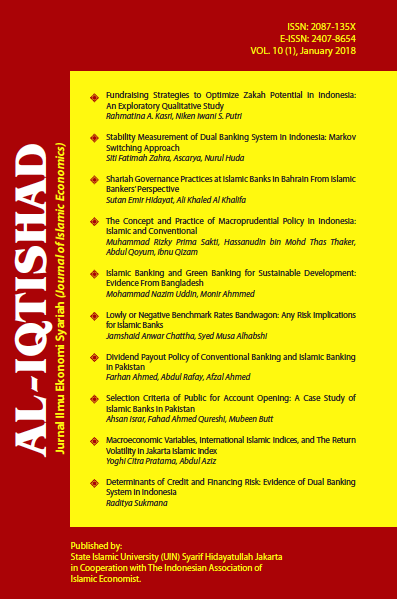Lowly or Negative Benchmark Rates Bandwagon: Any Risk Implications for Islamic banks?
DOI:
https://doi.org/10.15408/aiq.v10i1.6121Keywords:
negative rates, benchmark rates, Islamic banks, financial stabilityAbstract
To stimulate the economy, regulators across all jurisdictions have been taking unconventional approaches. Thus, in recent years, the management of benchmark rates (or interest rates) has received considerable prominence in the banking sector due to some reasons including supervision banks' benchmark rates under Basel II. This paper reviews the possible dysfunctional implications of lowly and/or negative rates and provides a risk management and regulatory perspective for Islamic banks. These consequences call for a better risk management with appropriate tools and effective supervisory oversight. It hoped that the initial discussion presented in this paper on the implications and controls invites a broader debate on this issue in the Islamic financial services industry.
References
Arteta, C., A. Kose., M. Stocker., & T. Taskin. (2016). Negative Interest Rate Policies: Sources and Implications. Working Paper 52/2016. Centre for Applied Macroeconomic Analysis, the Australian National University.
Ariss, R.T., & Sarieddine, Y. (2007). Challenges in Implementing Capital Adequacy Guidelines to the Islamic Banks. Journal of Banking Regulation. 9(1): 46-59.
Bacha, O. I. (2004). Dual banking Systems and Interest Rate risk for Islamic Banks. International Islamic University Malaysia. Retrieved 2014, from Munich Personal RePEc Archive: http://mpra.ub.uni-muenchen.de/12763/.
Basel Committee on Banking Supervision (BCBS). (2006). International Convergence of Capital Measurement and Capital Standards. Basel: Bank for International Settlements.
Basel Committee on Banking Supervision (BCBS). (2015). Consultative Document on Principles for the Management and Supervision of Interest Rate Risk. Basel: Bank for International Settlements.
Bean, C., C. Broda., T. Ito., & R. Kroszner. (2015). Low for Long? Causes and Consequences of Persistently Low Interest Rates. Geneva Reports on the World Economy. (17). Geneva: International Center for Monetary and Banking Studies.
Bech, M. L., & A. Malkhozov. (2016). How Have Central Banks Implemented Negative Policy Rates?. BIS Quarterly Review March. Basel: Bank for International Settlements
Busch, R., & C. Memmel. (2015). Banks' Net Interest Margin and The Level of Interest Rates. Working Paper No. 16/2015. Deutsche Bundesbank, Research Centre.
Genay, H., & R. Podjasek. (2014). What is The Impact of a Low Interest Rate Environment on Bank Profitability?. Chicago Fed Letter, (Jul).
Chattha, J. A., & O.I. Bacha. (2010). Duration Gaps and Net Worth Risk for Islamic and Conventional Banks: a Comparative Cross-country Analysis. Review of Islamic Economics. 13(2): 5-33.
Chattha, J. A. (2013). Significance and Key Challenges in Conducting Stress Testing for Islamic Commercial Banks. Global Review of Islamic Economics and Business. 1(2): 85-98.
Chattha, J.A. (2016). Risk Management with Stress Testing in Islamic Banks. Islamic Finance Today, Pioneer Publications (PVT) Ltd., pp. 14-20, Colombo, Sri Lanka.
Chattha, J. A., & Archer, S. (2016). Solvency Stress Testing of Islamic Commercial Banks: Assessing the Stability and Resilience. Journal of Islamic Accounting and Business Research. 7(2): 112-147.
Cihak, M., & H. Hesse. (2008). The Islamic Banks and Financial Stability: an Empirical Analysis. Working Paper No. WP/08/16. Washington: International Monetary Fund.
Hardy, D.C., & P. Hochreiter. (2014). A Simple Macroprudential Liquidity Buffer. IMF Working Paper, WP/14/235. Washington: International Monetary Fund.
Islamic Financial Services Board. (2005). IFSB-1: Guiding Principles on Risk Management for Institutions (Other Than Insurance Institutions) Offering Only Islamic Financial Services. Kuala Lumpur: IFSB.
Islamic Financial Services Board. (2011). IFSB GN-4: Guidance Note in Connection With the IFSB Capital Adequacy Standard: the Determination of Alpha in The Capital Adequacy Ratio for IIFSs. Kuala Lumpur: IFSB.
Islamic Financial Services Board. (2012). IFSB-13: Guiding Principles on Stress Testing for Institutions Offering only Islamic Financial Services (Excluding Islamic Insurance (Takâful) Institutions and Islamic Collective Investment Schemes). Kuala Lumpur: IFSB.
Islamic Financial Services Board. (2014). IFSB-16: Revised Guidance on Key Elements in The Supervisory Review Process for Institutions (Other Than Insurance Institutions) Offering only Islamic Financial Services. Kuala Lumpur: IFSB.
Islamic Financial Services Board. (2015). IFSB-17: Core Principles for Islamic Finance Regulation (Banking Segment). Kuala Lumpur: IFSB.
Islamic Financial Services Board. (2016). Islamic Financial Services Industry Stability Report. Kuala Lumpur: IFSB.
International Monetary Fund. (2016). Global Financial Stability Report. Washington: International Monetary Fund.
Jobst, A., & H. Lin. (2016). Negative Interest Rate Policy (NIRP); Implications for Monetary Transmission and Bank Profitability in the Euro Area. Working Paper No. 16/172. Washington: International Monetary Fund.
Khan, T., & H. Ahmed. (2001). Risk Management: an Analysis of Issues in Islamic Financial Industry. Jeddah: Islamic Development Bank, Islamic Research and Training Institute.
Omar, M., A.M. Noor., A.K.M. Meera., T.A.A. Manap., M.S.A. Majid., & M.A. Sarif. (2010). Islamic Pricing Benchmarking. ISRA research paper, (17). Kuala Lumpur: ISRA.
Linnemann, M. (2016). How Have Central Banks Implemented Negative Policy Rates?. BIS Quarterly Review. Basel: Bank for International Settlements
Standard and Poor. (2016). Islamic Finance in 2017: Modest Growth and Amid Oil-Prices Woes. Retrieved from www.standardandpoort.com/ratingsdirect.

